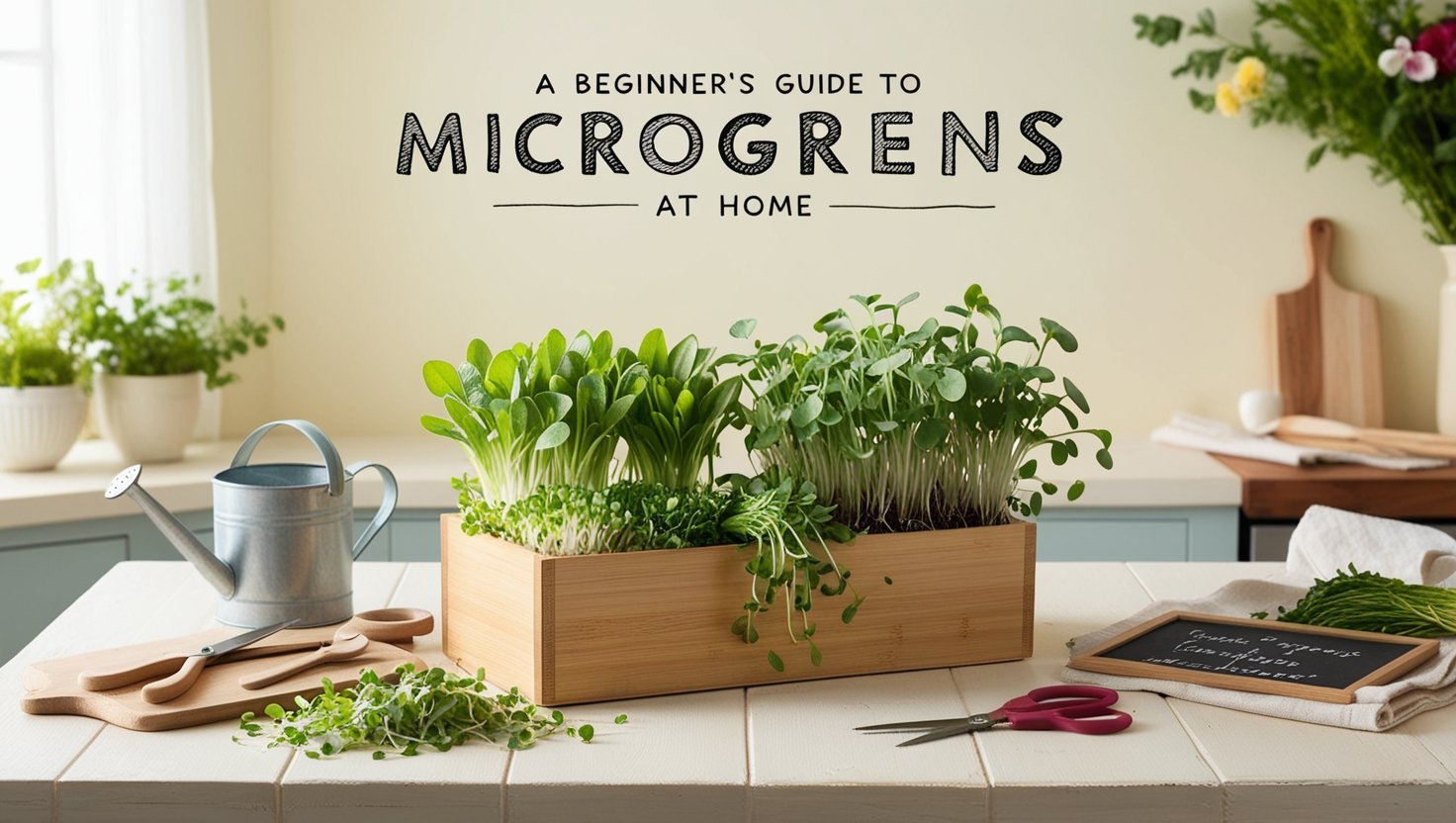
How to Grow Microgreens at Home: A Beginner’s Guide
Did you know microgreens have up to 40 times more nutrients than full-grown plants? This shows how great these tiny greens are for our health. If you want to add more vitamins to your meals or grow your own food at home, growing microgreens is easy and fun.
Microgreens are young plants full of vitamins A, C, and K, and minerals. Broccoli sprouts are special because they have sulforaphane, which fights cancer.
Growing microgreens is not just about nutrition. They need very little space, making them perfect for indoor growing. You only need seeds, water, and a growing medium to start. This guide will teach you how to grow microgreens at home. You’ll learn how to make your meals healthier with these greens.
Introduction to Microgreens
Microgreens are a big hit in home gardening because they grow fast and taste great. They are picked when they are young, usually 7 to 21 days after they start growing. You can find many types, from salad greens to herbs, in different flavors.
One great thing about microgreens is how nutritious they are. They have four to ten times more nutrients than full-grown greens. They are packed with vitamins like E, C, and K, and minerals like potassium, iron, and zinc. Eating microgreens might help prevent heart disease, diabetes, and some cancers.
Growing microgreens at home is great for people with little space. They need just a small area to grow. You’ll need shallow trays, organic soil, and a light source, like a 30-watt LED setup. You can even grow them on paper towels to make starting easier.
Microgreens are easy to grow indoors, outdoors, or in greenhouses. They add color and flavor to your food and are good for your health. Trying microgreens might change how you cook and eat.
Benefits of Growing Microgreens
Growing microgreens is great for health lovers and organic farming fans. These small plants are super nutritious, with nutrients up to nine times more than big greens. A study found that microgreens have vitamins and antioxidants 40 times more than big leaves. This makes them not only healthy but also tasty and varied for meals.
Microgreens are packed with compounds that fight cancer. For example, broccoli sprouts have sulforaphane, which might stop cancer cells from growing. Eating different microgreens can give you important minerals like potassium, zinc, and magnesium. This boosts your health.
By growing your own microgreens, you don’t have to buy them. You can have fresh greens all year with the right light and care. Growing microgreens is also calming and fun, making it a hobby that’s rewarding.
Microgreens are also super versatile in cooking. They can taste sweet, spicy, or earthy. They’re perfect for salads, sandwiches, and smoothies. Plus, they grow fast, so you always have fresh, healthy greens ready to eat.
What You Need to Grow Microgreens at Home
Growing microgreens at home is a fun way to enjoy fresh greens. It also lets you practice indoor gardening. To start, you need the right supplies for growing microgreens. Having the right equipment is key to a successful harvest.
Essential Supplies for Indoor Microgreen Cultivation
Here are the supplies you need for growing microgreens:
- Seeds: Choose the best microgreens for home, like broccoli, radish, and sunflower seeds.
- Growing Medium: Use coconut coir or potting mix to keep the soil moist.
- Containers or Trays: Pick shallow containers with holes for drainage to prevent too much water.
- Watering Equipment: A spray bottle is great for watering.
- Sunlight Source: Make sure your plants get enough sunlight. Use grow lights if it’s not sunny enough.
You don’t need to buy special kits. Many household items can be used, saving you money.
Choosing the Right Seeds for Microgreens
Choosing the right seeds is important for a healthy indoor garden. Some popular seeds include:
- Broccoli
- Mustard
- Kale
- Arugula
- Sunflower
Look for untreated seeds without harmful chemicals. Thicker seeds are easier to handle and grow better. Beginners might want to start with just one type of seed in each container.
Easy Microgreen Gardening Techniques
Starting with microgreens is easy with a few key techniques. You need to know how to prepare the soil, choose the right trays, and water them well. These steps are vital for a successful harvest.
Preparing Growing Trays and Soil
Getting your growing trays and soil ready is important. Use trays with good drainage to avoid waterlogged soil. Shallow trays are best because they let roots grow while keeping moisture in.
Start by filling the tray with a mix of sphagnum peat moss, perlite, and compost. Before planting, make the soil moist but not too wet. This helps seeds germinate well. You can add liquid kelp or compost to boost the soil’s nutrients.
Spread the seeds evenly over the soil, covering them lightly. This gets them ready for growth.
Optimal Watering Methods for Microgreens
Watering microgreens needs careful attention. It’s important to keep the soil just right for growth. Use a spray bottle to keep the soil damp after planting. This helps seeds germinate without getting too wet.
Once seeds sprout, switch to bottom-watering. This method lets microgreens get moisture from the bottom while excess water drains. Keep an eye on the moisture to ensure the best growing conditions.
How to Grow Microgreens at Home
Growing microgreens at home is rewarding, perfect for beginners. It’s easy to create a mini-garden that adds color and nutrition to your meals. Here’s a simple guide to growing microgreens successfully.
Step-by-Step Guide to Growing Microgreens
To start, follow these steps:
- Soak Seeds: Soak your seeds up to 24 hours before planting if needed.
- Prepare Growing Medium: Fill a shallow container with potting mix. Make sure it’s level and moist.
- Sow Seeds: Spread your seeds evenly over the soil. Cover them lightly with soil.
- Cover and Wait: Cover the seeds with a lid or tray. Keep them dark until they germinate, which takes 3-7 days.
- Add Light: Once they sprout, remove the cover. Place them in a spot with at least four hours of sunlight daily.
- Water Regularly: Keep the soil damp but not too wet. Start harvesting when they’re about 2 inches tall.
Common Microgreens to Start With
Choosing the right seeds is key for beginners. Here are some easy ones to start with:
- Pea Shoots: They grow fast and taste sweet, ready in about a week.
- Radishes: Quick to germinate, they add a spicy flavor in 5-10 days.
- Mustard Greens: With a peppery taste, they grow well in a week.
These microgreens are great for beginners. As you get better, try more varieties. Microgreens are ready to harvest in two to three weeks, making them perfect for home gardens.
Microgreen Care Instructions
Proper care is key for growing vibrant microgreens. Knowing what they need ensures they grow well and taste great. Managing light and water is important for healthy greens in your indoor garden.
Light Requirements for Healthy Growth
Microgreens need plenty of light to grow strong, about 10 to 12 hours a day. A south-facing window works well. If it’s too dark, grow lights can help, like in winter.
Without enough light, microgreens can become leggy and pale. To keep them healthy, aim for 12-15 hours of light each day. This helps them grow strong and flavorful.
Watering and Nutrient Management
Keeping the soil moist is vital for microgreens. Use a light spray of water every day to keep it right. Check the soil and water it twice a day if needed.
Too much water can cause mold, while too little harms the seedlings. Microgreens usually don’t need extra fertilizers. But, if you must, use a weak liquid fertilizer to help them grow.
Harvesting and Using Your Microgreens
Growing microgreens opens up many cooking options. Knowing when to harvest them is key for the best taste and nutrients. Microgreens are ready to pick 7 to 21 days after planting, when they have their first true leaves. Harvest them in the morning for the most nutrients.
Use sharp scissors to cut the microgreens just above the soil. This way, you don’t harm the plants and they get air.
When to Harvest Microgreens
Several things help decide when to pick microgreens. Look for these signs:
- Presence of the first true leaves
- A vibrant color and sturdy appearance
- The height of 1-3 inches depending on the variety
Different microgreens grow at different rates. Mustard and kale grow faster than radish and broccoli. This makes them great for beginners.
Creative Ways to Incorporate Microgreens into Your Meals
Microgreens make dishes look and taste better. Here are some ideas:
- Add them as a fresh topping on salads to enrich flavor.
- Use microgreens as a garnish for soups, creating an attractive presentation.
- Incorporate them into smoothies for an extra boost of vitamins.
- Layer microgreens on sandwiches or bagels for a crunchy texture.
These small greens can make simple meals exciting. Learning to harvest and use microgreens can improve your cooking skills.
Troubleshooting Common Issues
Growing microgreens can be rewarding, but you might face challenges. It’s important to know about mold and low germination rates. This section will help you prevent mold and solve growth problems to improve your gardening.
Identifying and Preventing Mold
Mold can ruin your microgreen crop. High humidity is a big contributor. To prevent mold, keep the moisture right.
- Clean trays before each use to eliminate dirt and bacteria.
- Bottom watering keeps stems dry while roots get moisture.
- Use a professional and cleaned substrate to avoid contaminants.
- Watch germination temperatures to prevent mold.
If mold shows up, remove it gently and improve air flow. It’s key to tell root hairs from mold to keep plants healthy.
Dealing with Low Germination Rates
Low germination rates can come from old seeds, wrong watering, or not enough light. To boost germination, try these tips:
- Choose fresh seeds from trusted sources.
- Water right; too much can cause rot and poor growth.
- Make sure there’s enough light, or use a short blackout period for some varieties.
- Soak seeds before planting to help them germinate faster.
By tackling these germination issues, you can greatly improve your microgreen growing success.
Growing Microgreens in Small Spaces
Microgreens are great for small gardens because they grow compactly. They need little space to thrive, making them ideal for indoor gardens. You can even grow them in your kitchen, using sunny windowsills to their fullest.
Utilizing Your Kitchen for Indoor Gardening
Starting an indoor microgreens garden is simple. Just put growing trays on countertops or tables near the light. Microgreens need 4-6 hours of sunlight each day to grow well. A sunny window is perfect for them, making it easy to harvest.
Vertical and Stacked Growing Solutions
Vertical gardening is a smart choice for small spaces. You can use tiered shelves or stacked systems to grow more microgreens. These methods save space and time. Plus, they make your garden look good and work well.
Conclusion
Growing microgreens is a rewarding indoor gardening activity for everyone. It requires little equipment and can be ready to eat in just 8 to 12 days. This makes microgreens a great choice over store-bought greens.
This guide shows how easy it is to grow microgreens at home. They are not only healthy but also add flavor and color to any meal. Beginners can start with varieties like radish, arugula, and broccoli.
Microgreens are more than just food; they bring joy to gardening at home. Start growing microgreens and enjoy the satisfaction of having your own green space.
